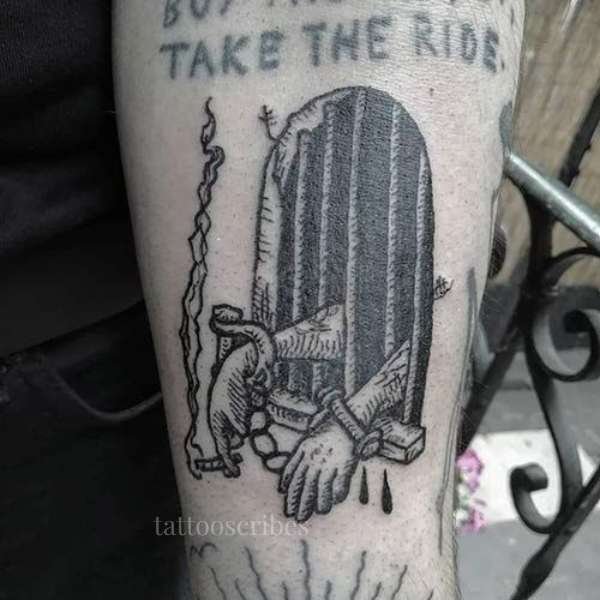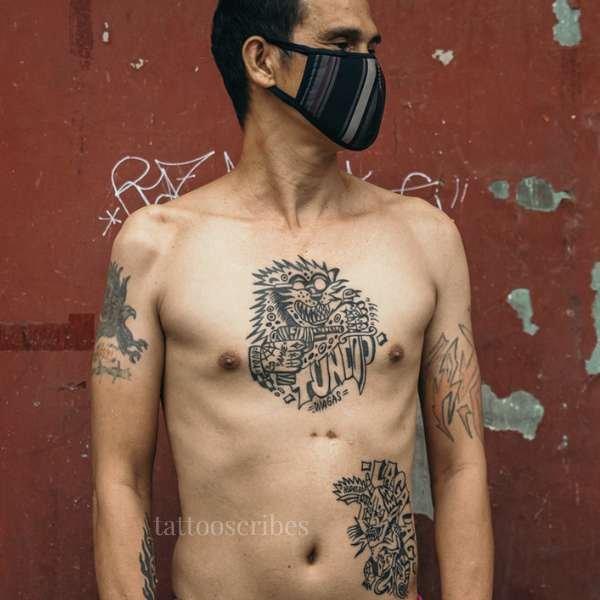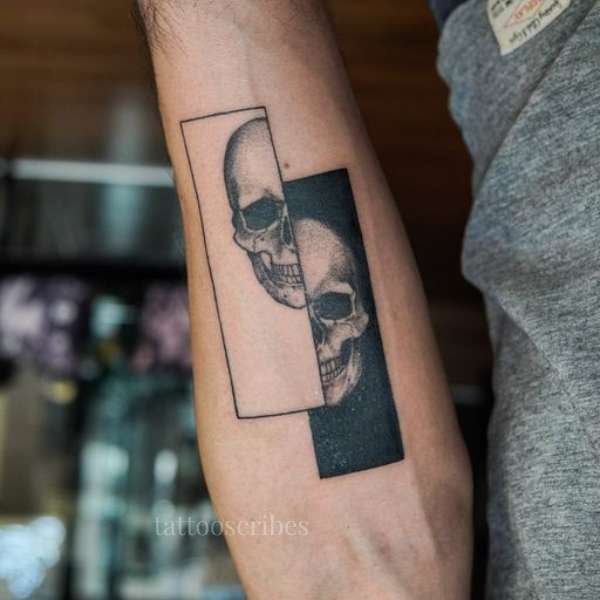A jailhouse tattoo might not be your first choice, but it’s a popular tattoo with deep meaning.
Whether you’re thinking about this body art as a symbol of personal growth or drawn to its boldness, tattoos like these carry rich symbolism.
Discover how these designs can represent your unique journey, from rising from the ashes to symbols of protection. Keep reading for a deeper look!

What do jailhouse tattoos mean?
Jailhouse tattoos symbolize survival, identity, and belonging within prison culture. Each design, from teardrops to spider webs, reflects personal stories, affiliations, or time served. These tattoos are significant, often carrying messages of resilience and adaptation.
Origins and Evolution of Jailhouse Tattoos
The practice of jailhouse tattoos dates back to the early days of incarceration. Inmates used essential tools like pens, paperclips, and ink made from ash and water to mark themselves.
These tattoos initially served as identifiers, showing allegiance to specific groups or gangs within the prison. Over time, they evolved into a complex system of symbols with unique meanings.
Common Jailhouse Tattoo Designs
Teardrop Tattoos
One of the most recognizable jailhouse tattoos is the teardrop, often found under the eye.
Contrary to popular belief, the meaning of a teardrop tattoo varies depending on where it’s placed and how many teardrops are inked.
A single teardrop might signify the loss of someone close, while multiple teardrops often represent years spent in prison or acts of violence committed.
Spider Webs
Spider web tattoos, usually seen on elbows or necks, symbolize time served in prison.
The number of rings within the web indicates the years incarcerated, displaying the wearer’s status within the prison community.
Playing Cards
Tattoos of playing cards are common in prisons, where each card holds a specific meaning.
For example, the ace of spades might signify a preference for solitude, while the queen of hearts could represent a romantic relationship or longing for loved ones outside prison walls.
Religious Symbols
Inmates often seek solace and protection through religious imagery, such as crosses, rosary beads, or depictions of religious sculptures, such as Jesus or the Virgin Mary.
These symbols reflect faith and spiritual strength amid the challenges of prison life.
Barbed Wire
Barbed wire tattoos symbolize incarceration itself, serving as a stark reminder of the physical and psychological boundaries of prison life.
They represent the loss of freedom and the harsh realities faced by inmates daily.
The Cultural Significance of Jailhouse Tattoos
Beyond their visual appeal, jailhouse tattoos play a crucial role in prison culture as a form of communication.
They convey messages about an individual’s past, allegiances, and personal beliefs to other inmates.
Understanding these tattoos offers insight into the intricate social dynamics and hierarchies that govern life behind bars.
You may also like below posts:
Risks and Considerations
While jailhouse tattoos hold deep personal meaning for inmates, they also pose risks.
These tattoos are often applied under unhygienic conditions, increasing the chances of infections and the transmission of bloodborne diseases like HIV and hepatitis.
Additionally, their permanence means individuals may carry reminders of their past long after leaving prison.

Choosing a Jailhouse Tattoo Style
Jailhouse tattoos are known for their raw, symbolic look, often made with makeshift tools. If you’re getting one outside prison, choose an artist who understands the style’s history and can replicate its unique imperfections with meaning and precision.
Read more about choosing the right jailhouse tattoo artist here.
Tattoo Aftercare
Keep your tattoo clean with mild soap and moisturize carefully to avoid blurring the rough lines. Please protect it from sun exposure to prevent fading, especially with the bold black ink ordinary in jailhouse tattoos.
Explore more aftercare tips here.
Real-Life Examples and Testimonials
Stories from Wearers
For many, jailhouse tattoos tell a story. Take James, for example, who had his first jailhouse tattoo—a simple cross—done while he was serving time. It wasn’t just about rebellion; for him, it symbolized finding faith in the darkest moments.
Then there’s Mia, who got a teardrop tattoo to honor her brother’s memory, but she later expanded the design into a custom piece symbolizing growth and redemption after her release. These tattoos might look simple, but their meanings often run deep.
Celebrity Inspirations
Several celebrities have drawn inspiration from jailhouse tattoos, adding their twists.
Take Post Malone—his tattoos reflect a mix of personal style and rough, raw designs, often resembling jailhouse aesthetics.
These designs remind us how tattoos, even when imperfect, can hold powerful personal meanings.

Cultural Sensitivity and Ethical Considerations
Respect for Jailhouse Tattoo Culture
Jailhouse tattoos aren’t just about the art—they’re about survival, belonging, and personal expression in harsh conditions.
Symbols like spiderwebs, teardrops, and numbers can represent gang affiliations, personal losses, or time spent behind bars.
If this style inspires you, take the time to understand its origins and avoid designs that might misrepresent their meaning.
For example, teardrops under the eye can carry heavy implications that might not align with your intentions.
Appropriateness of Jailhouse Tattoo Designs
Before getting a jailhouse-inspired tattoo, think about what it represents. Designs like barbed wire or gang-specific symbols might send unintended messages.
Instead, work with your tattoo artist to create a piece inspired by the style but with personal meaning. This approach lets you embrace the aesthetic while keeping it authentic to your own story.
Wrapping It Up 🎨
Jailhouse tattoos go beyond ink—they tell stories of resilience, faith, and survival. Each symbol carries a deep meaning tied to life behind bars.
We gain insight into this raw art form by understanding its origins and significance. What are your thoughts on the cultural impact of jailhouse tattoos?
Share your perspective in the comments below! 👇
